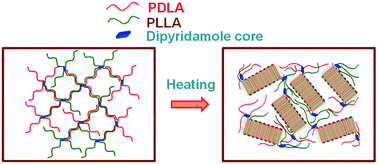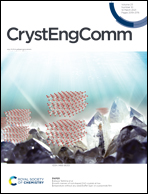Stereocomplexation of enantiomeric star-shaped poly(lactide)s with a chromophore core†
Abstract
Herein, we aim to investigate the influence of the cooling rate from the melt on stereocomplex formation of equimolar blends of enantiomeric star-shaped poly(lactide)s with a dipyridamole core. As evidenced by differential scanning calorimetry, wide-angle X-ray scattering and Fourier-transform infrared spectroscopy, melt cooling of equimolar blends of star-shaped poly(L-lactide) (SSPLLA) and star-shaped poly(D-lactide) (SSPDLA) resulted in the non-crystalline state. A careful analysis of WAXS and FTIR data revealed that the slow-cooled sample (10 °C min−1) exhibited the amorphous phase and the fast-cooled sample (50 °C min−1) resulted in the mesophase. On subsequent heating, the slow-cooled sample remained in the amorphous phase, whereas the fast-cooled sample crystallized (cold crystallization) exclusively into the stereocomplex at ∼90 °C. Aging of the slow-cooled sample at room temperature and subsequent heating led to the formation of the stereocomplex. Photoluminescence studies revealed that the cooling rate from the melt has a strong influence on core molecule (dipyridamole) aggregation and determines the geometry of interactions between the branches of SSPLLA and SSPDLA. In the slow-cooled sample, because of the longer residence time above the glass transition temperature, dipyridamole molecules form aggregated structures, whereas in the fast-cooled sample, dipyridamole molecules are distributed within the polymer matrix without much aggregation. Based on these results, we propose antiparallel chain packing in fast-cooled SSPLLA/SSPDLA blends because of the non-aggregation of dipyridamole core molecules and this geometry favored the exclusive formation of stereocomplex. On the other hand, due to the possible aggregation of dipyridamole molecules, the slow-cooled sample led to topological and geometric constraints where the interactions between SSPLLA and SSPDLA chains prevented the crystallization. The present findings could open new avenues for the design of a variety of macromolecular architectures for a better understanding of the stereocomplex formation mechanism of chiral polymers.

- This article is part of the themed collection: Supramolecular & Polymorphism


 Please wait while we load your content...
Please wait while we load your content...